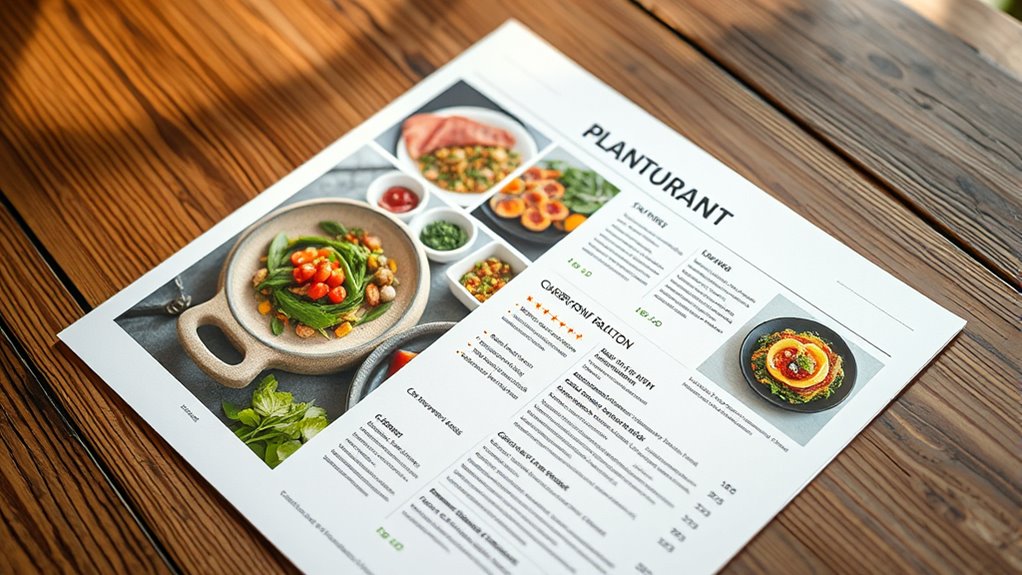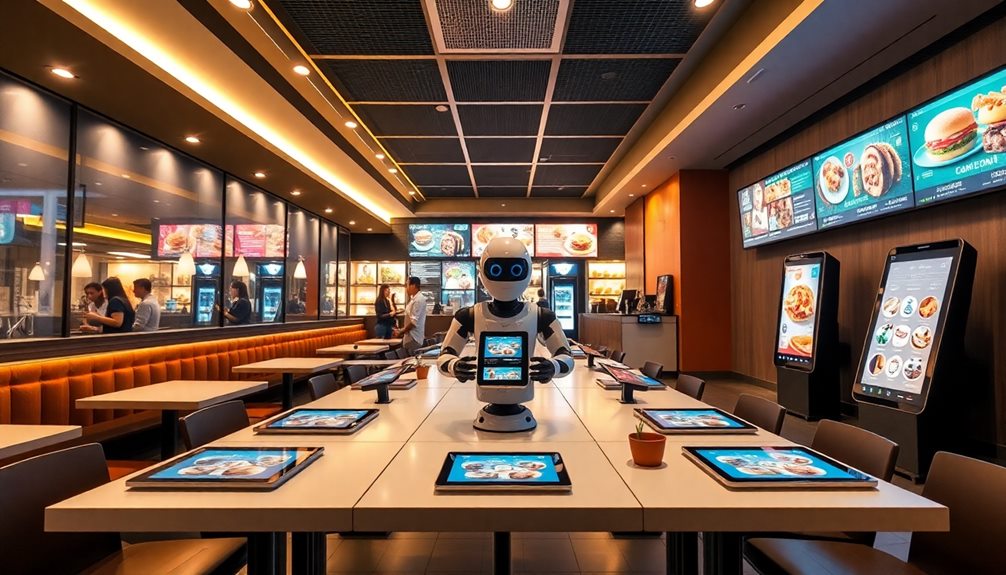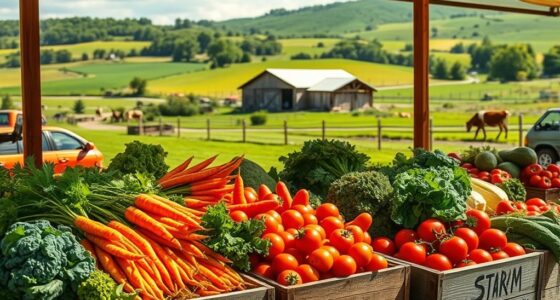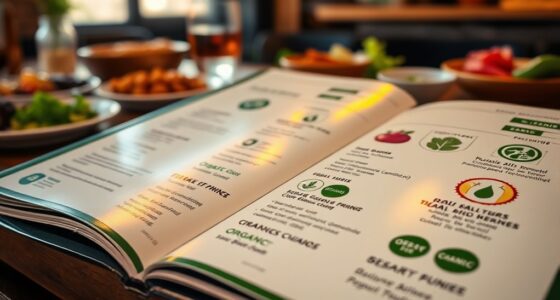Carbon-tracking tools for menus help you measure and display the environmental impact of your dishes by gathering data on ingredients, sourcing, transportation, and energy use. They use models and databases to estimate greenhouse gas emissions, offering real-time insights that can be integrated into digital menus. This transparency encourages eco-friendly choices and builds customer trust. To discover how these tools can transform your restaurant’s sustainability efforts, explore more about their implementation and future innovations.
Key Takeaways
- Carbon-tracking tools integrate menu data, sourcing, and preparation methods to calculate the environmental impact of each dish.
- They utilize emission factors and supply chain data to estimate greenhouse gases from ingredients and processes.
- Real-time tracking and API integrations enable dynamic updates as menus change or new ingredients are introduced.
- Advanced tools incorporate blockchain and transparency features for verified supply chain emissions.
- These tools support eco-friendly menu design, helping restaurants reduce carbon footprints and promote sustainability.
The Rise of Sustainability in the Food Industry
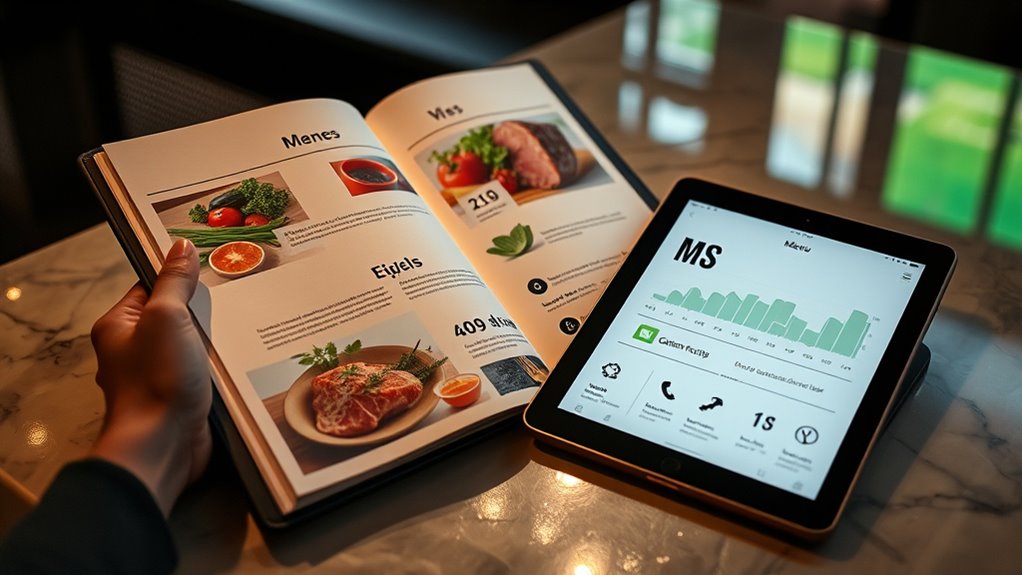
Sustainability has become a key focus in the food industry as consumers demand more eco-friendly options and companies seek to reduce their environmental impact. You notice that more restaurants and food brands are prioritizing sustainable practices, like sourcing local ingredients and minimizing waste. This shift is driven by consumer awareness about climate change and the environmental footprint of food production. You see menus now highlighting eco-friendly choices, and businesses are adopting greener supply chains. The industry recognizes that sustainability isn’t just a trend but a responsibility. By integrating sustainable practices, you help support environmental health while appealing to conscientious customers. This growing emphasis on eco-consciousness shapes how food companies operate, innovate, and communicate their values to the public.
How Carbon-Tracking Tools Work in Practice
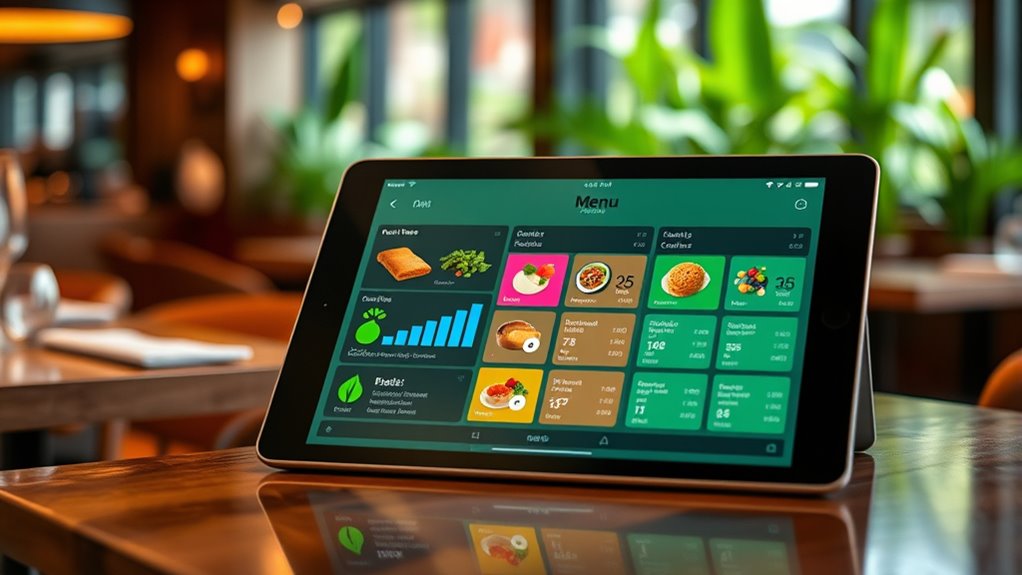
You’ll see how carbon-tracking tools gather data through various methods like monitoring ingredient sources and energy use. These tools then apply emission calculation models to estimate the environmental impact of menu items. Additionally, they can incorporate mindfulness techniques to help operators interpret data more effectively and make informed decisions. Finally, they integrate this information directly into menus, helping you make more sustainable choices in real time.
Data Collection Methods
How do carbon-tracking tools gather accurate data on emissions? They rely on a mix of direct measurements, supplier data, and existing databases. First, they collect ingredient information, including sourcing locations and transportation methods. Many tools integrate with suppliers’ systems or request detailed data to guarantee accuracy. They also track cooking processes, energy use, and waste management practices within the kitchen. Some tools utilize sensors or smart devices to monitor energy consumption directly. Additionally, they reference standardized emission factors from trusted databases to estimate emissions for each activity or ingredient. By combining these data sources, carbon-tracking tools create a thorough picture of your menu’s environmental impact. This multi-layered approach helps identify key emission sources and ensures the data’s reliability for meaningful analysis. Incorporating high-precision measurements enhances the accuracy of the tracking process further.
Emission Calculation Models
Once all relevant data has been collected, emission calculation models process this information to estimate the environmental impact of your menu. These models use standardized emission factors to convert quantities of ingredients, energy use, and transportation into carbon emissions. You input data such as ingredient weights, cooking methods, and supply chain details, and the model applies algorithms to calculate the total greenhouse gases produced. Many models account for different stages, from farm to plate, providing a holistic footprint. They may also adjust for regional variations or specific practices to improve accuracy. Incorporating alternative materials like oils and wax substitutes can further refine the emission estimates. The goal is to give you a clear picture of your menu’s carbon impact, enabling informed decisions to reduce emissions. Accurate models help you target high-impact areas and track improvements over time.
Integration With Menus
Integrating carbon-tracking tools with menus involves seamlessly connecting data inputs such as ingredient lists, preparation methods, and supply chain details to the software. You input ingredient quantities, sourcing information, and cooking techniques, allowing the tool to analyze the environmental impact accurately. This process often uses APIs or manual data entry, ensuring real-time updates as menus change. By linking these details, the software calculates carbon footprints for each dish, providing immediate feedback on sustainability. You can then adjust recipes or sourcing to reduce emissions. The integration helps streamline your workflow, making sustainability an integral part of menu planning. Overall, this seamless connection between your menu data and the tracking tools makes carbon footprint management practical and actionable. Incorporating natural materials and rustic decor elements can further enhance the eco-friendly aspect of your restaurant environment.
Benefits of Displaying Carbon Footprints on Menus
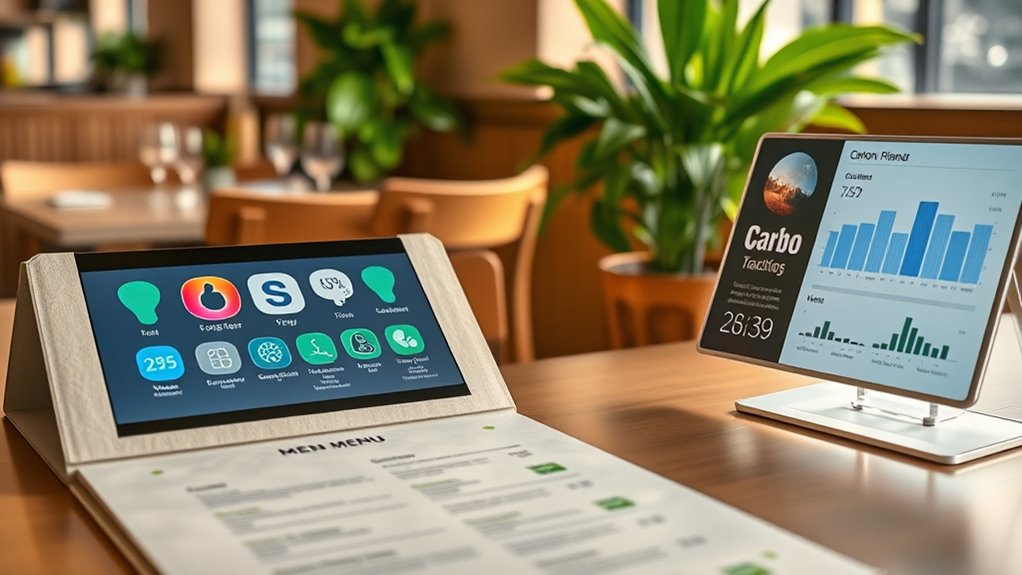
Showing carbon footprints on menus helps you make more sustainable choices effortlessly. It also educates you about the environmental impact of your meal, encouraging responsible dining habits. By doing so, restaurants can inspire customers to contemplate their carbon footprint with every order. Implementing such transparency aligns with the importance of transparency in affiliate relationships and enhances consumer trust.
Promotes Sustainable Choices
Displaying carbon footprints on menus encourages diners to make more sustainable choices by making the environmental impact of their meals clear. When you see the carbon footprint next to each dish, you’re more likely to choose options with lower emissions, supporting eco-friendly practices. This transparency guides you toward dishes like plant-based meals, which typically have smaller footprints. Imagine a menu where:
| Dish | Carbon Footprint | Sustainable Choice? |
|---|---|---|
| Grilled Salmon | 5 kg CO₂e | No |
| Veggie Stir-fry | 1 kg CO₂e | Yes |
| Beef Burger | 12 kg CO₂e | No |
This visual cue helps you quickly identify greener options, encouraging you to make decisions that benefit the environment while satisfying your palate. Promoting metabolic health through mindful choices can also support overall well-being.
Educates on Environmental Impact
Have you ever wondered how knowing the environmental impact of your meal influences your choices? When a menu displays a dish’s carbon footprint, you gain immediate insight into its ecological cost. This transparency helps you understand how your dining decisions affect the planet, making environmental impact clear and tangible. By seeing specific data, you become more aware of which foods contribute more to greenhouse gas emissions and which are more sustainable. This knowledge empowers you to make informed choices, aligning your meals with your values. Displaying carbon footprints educates you about the broader effects of your consumption habits, fostering a deeper understanding of sustainability. Additionally, mindful decluttering can help in organizing information and reducing clutter, making environmental data more accessible and easier to interpret. Ultimately, it transforms dining from a simple act into an opportunity to support environmental responsibility.
Encourages Responsible Dining
When menus feature carbon footprints, they actively encourage you to make responsible dining choices. Seeing the environmental impact of each dish helps you consider options that are more eco-friendly. Here’s how it benefits you:
- Informed decisions: You can choose meals with lower carbon footprints, reducing your environmental impact.
- Increased awareness: You become more conscious of how your food choices affect the planet.
- Empowerment: The information gives you the confidence to support sustainable practices.
- Influence on restaurants: Your preferences can motivate eateries to adopt greener menus and reduce their carbon emissions.
Integrating Carbon Data Into Restaurant Operations
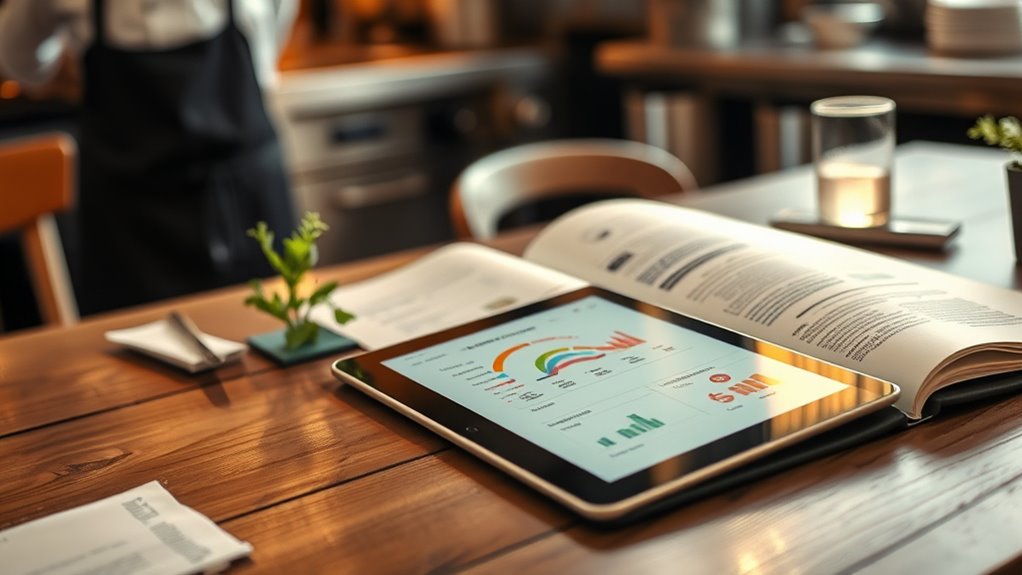
Integrating carbon data into restaurant operations enables you to identify key areas where emissions can be reduced, making your efforts more targeted and effective. By analyzing data on energy use, supply chain impacts, and waste management, you gain a clearer picture of your restaurant’s environmental footprint. This insight allows you to prioritize actions such as switching to greener suppliers, optimizing energy consumption, or reducing food waste. With real-time data, you can monitor the impact of your changes and adjust strategies accordingly. Embedding carbon data into daily operations fosters a culture of sustainability, encouraging staff to stay engaged. Additionally, understanding the supply chain impacts can help you select more sustainable ingredients and vendors. Ultimately, this integration helps you make smarter decisions that lower your restaurant’s carbon footprint while maintaining quality and profitability.
Challenges and Limitations of Carbon-Tracking Technologies
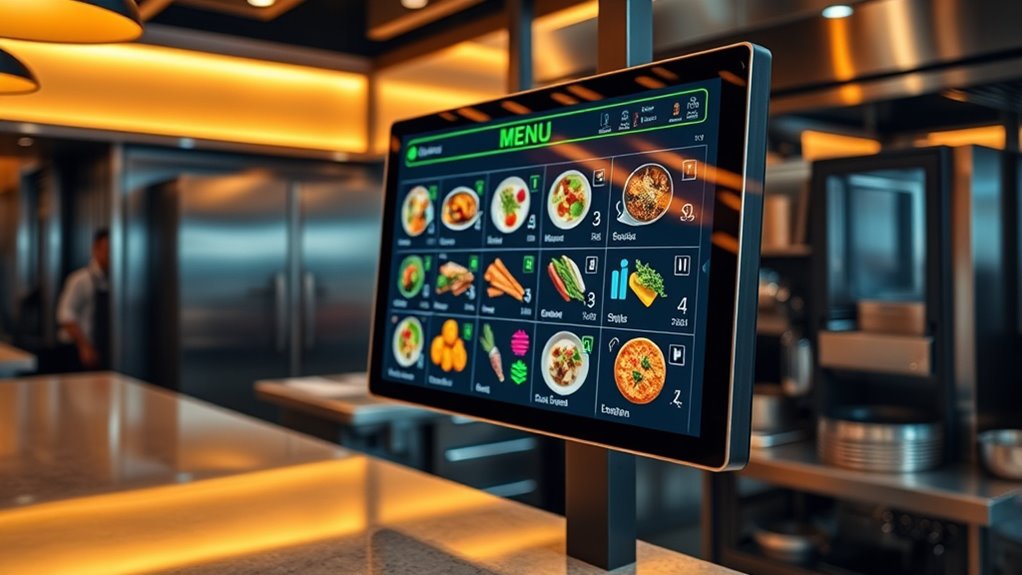
While carbon-tracking technologies offer valuable insights, they also face significant challenges that can limit their effectiveness. First, data accuracy can be compromised due to inconsistent reporting methods across suppliers and regions. Second, tracking emissions from complex supply chains often involves estimations, which reduce reliability. Third, integrating carbon data into existing restaurant systems can be technically difficult and costly. Fourth, these tools might not account for all indirect emissions, leading to incomplete assessments. Additionally, you may encounter resistance from staff or suppliers hesitant to adopt new processes. Despite their benefits, these limitations mean you should interpret carbon data cautiously, understanding it provides estimates rather than exact measurements. Furthermore, the accuracy of data collection can be affected by the variability in how suppliers report their emissions. Addressing these challenges is essential to making meaningful improvements in your restaurant’s environmental impact.
Case Studies of Restaurants Using Carbon-Tracking Tools
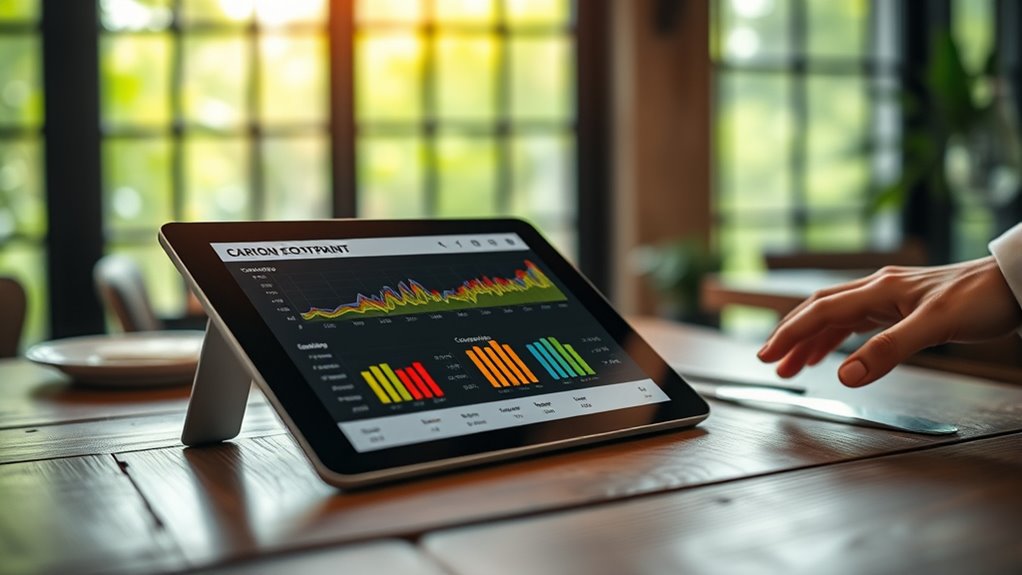
Many restaurants have begun incorporating carbon-tracking tools to better understand and reduce their environmental footprints. Take GreenBite Café, which tracked its supply chain emissions and identified major sources like dairy and beef. By switching to plant-based options, they cut their carbon footprint by 20%. Similarly, EcoEats prioritized local sourcing, reducing transportation emissions considerably. You can visualize their efforts with this table:
| Restaurant | Focus Area | Result | Strategy | Impact |
|---|---|---|---|---|
| GreenBite | Supply chain emissions | 20% reduction in carbon footprint | Switching to plant-based ingredients | Lowered overall emissions |
| EcoEats | Sourcing and transportation | 15% decrease in transportation emissions | Local sourcing | Improved sustainability |
| FreshFork | Waste management | 10% reduction in food waste | Composting and recycling | Reduced environmental impact |
| Veggie Haven | Menu redesign | Increased veggie options | Promoting plant-based dishes | Lowered emissions from meat |
| OceanBite | Seafood sourcing | Certified sustainable seafood | Partnering with eco-friendly suppliers | Preserved marine life |
Additionally, implementing sustainable practices can further enhance these efforts and lead to greater environmental benefits.
Future Trends in Eco-Friendly Dining and Transparency
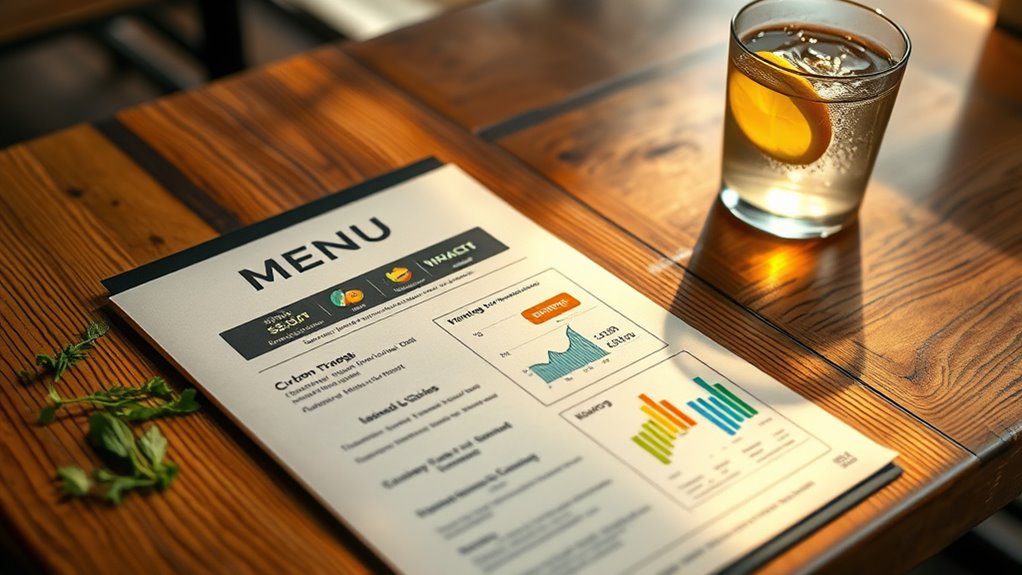
As consumer awareness of environmental issues grows, restaurants are increasingly adopting innovative approaches to enhance transparency and demonstrate their commitment to sustainability. Future trends include:
- Real-time carbon footprint tracking integrated into menus, allowing diners to see the environmental impact of their choices instantly.
- Blockchain technology providing transparent, tamper-proof supply chain data, so you can verify the origin and sustainability of ingredients.
- Personalized eco-friendly recommendations based on your preferences, helping you make greener dining decisions effortlessly.
- Interactive, digital menus that educate customers on sustainability efforts and encourage eco-conscious participation.
These advancements empower you to make informed, environmentally friendly choices while dining, fostering a more transparent and sustainable restaurant experience.
Frequently Asked Questions
How Accurate Are Current Carbon-Tracking Tools for Menu Items?
You might wonder how precise these tools are. Currently, carbon-tracking tools for menu items provide rough estimates based on average data and supply chain info. While they give useful insights, they can’t account for every variable like specific sourcing or cooking methods. So, don’t rely solely on them for absolute accuracy. Use them as a guide to make more sustainable choices, but remember, they’re not perfect.
What Are the Costs Associated With Implementing Carbon-Tracking Technology?
Imagine you’re stepping into the future, where tracking emissions costs are quite varied. Implementing carbon-tracking technology involves initial investments in software, sensors, and staff training, which can range from a few thousand to tens of thousands of dollars. Ongoing expenses include maintenance, updates, and data analysis. While costs may seem hefty, the long-term benefits of sustainability and consumer trust can outweigh these upfront investments, making it a smart, eco-friendly move.
How Do Customer Perceptions Influence the Success of Eco-Labeling Menus?
Customer perceptions play a vital role in the success of eco-labeling menus. When you understand that customers value sustainability, you can highlight eco-friendly choices effectively. Positive perceptions boost trust and encourage more orders of eco-labeled dishes. Conversely, if customers see eco-labeling as insincere or confusing, it may backfire. By fostering transparency and educating your patrons, you improve their perception, increasing the chances they’ll choose sustainable options regularly.
Are There International Standards for Measuring and Reporting Food Carbon Footprints?
Think of international standards for measuring food carbon footprints as the GPS guiding eco-friendly choices. Currently, no single global standard exists, but organizations like ISO and the Greenhouse Gas Protocol aim to establish consistent methods. You should stay updated, as these standards can help you compare and communicate your environmental impact clearly. Using common benchmarks ensures your efforts resonate across borders, turning your sustainability journey into a global voyage.
How Can Small Restaurants Adopt Carbon-Tracking Tools Effectively?
You can adopt carbon-tracking tools effectively by starting small and focusing on key menu items. Choose user-friendly tools that fit your restaurant’s size and budget, and train your staff to use them regularly. Incorporate tracking into your daily operations, set achievable goals, and analyze data to identify areas for improvement. Partner with suppliers for sustainability data, and communicate your efforts to customers to build eco-conscious loyalty.
Conclusion
As you explore the world of eco-friendly dining, picture your favorite restaurant glowing with sustainability. With carbon-tracking tools guiding transparency, you can savor your meal knowing it’s made with care for the planet. Every dish on the menu becomes a step toward a greener future, turning your dining experience into a powerful act of environmental support. Embrace this shift, and let your choices help paint a healthier, more vibrant world for generations to come.
